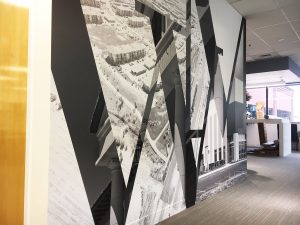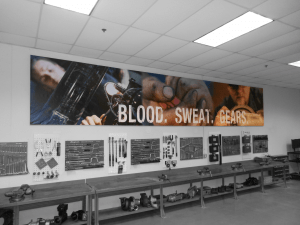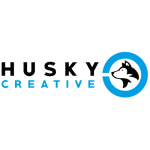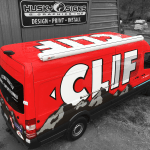We live in a sensorial world. Everything around us and everywhere we are is telling us something or generating some kind-of emotion. You could be walking through the city, shopping at stores in a mall, entering a new building, sitting on a park bench, or even walking in your office or workspace, no matter where we are, all of our surroundings are continually sending all sorts of different codes and messages that convey an endless variety of data, guidance, information and stories.
As we grow up, we learn how to interpret symbols, words and all sorts of different visual codes. Many visual elements from simple pictograms like traffic signs or WC signs on buildings, “don’t step on the grass” signs in parks to subway line maps, all converge together to make our lives easier. Our brain is trained to read, understand, and react to these stimulations in a blink of an eye, allowing us to live together in a civilized society.
From the beginning of civilizations, human beings have learned to use their environment and its elements at their disposal to communicate. This ability and knowledge, has evolved to what we know today as visual communication, which is a significant component in today’s modern EGD or environmental graphic design.
Understanding Environmental Graphic Design Principles

EGD can enhance a specific area, while motivating customers, partners and working staff on their daily tasks.
A comfortable and relaxing hospital waiting room, with nice soft colors, a beautiful highly detailed gigantic picture of a pine forest on its wall, with cozy and comfortable furniture, or a cool and powerful wall graphic on a college basketball gym, team colors on the locker room tunnels and bleachers with inspiring action pictures and messages displayed everywhere, are all great examples of environmental graphic design.
In these examples, designers used elements at their disposal, like the building’s architecture and structure to incorporate colors and visual tools, at the same time they used the clients’ goals and needs, to enhance the atmosphere of the area by conveying the desired messages and emotions. That is not a simple task at all. It requires extensive knowledge in a field that is composed of a vast number of different disciplines, such as architecture, graphic design, visual communication, interior design, signage, public art, urban planning, biophilia, landscape, and industrial design, to mention some of the most important ones.
Experiential graphic design or environmental graphic design, integrate visual elements like color, pattern, material, image, illustration, typography, pictograms, maps, infographics, and even digital technology, to the natural landscape or architectural structure, to convey specific information, messages and even stories. In simple words, experiential graphic design or EGD is the ability of strategically organizing together all or the most important visual elements in your surroundings, to achieve specific goals or provide a particular experience.
The potential of environmental graphic design is endless when you can master the visual communication of your elements. Today, environmental graphic designers take their project to health care facilities, educational and academic institutions, workspaces, and of course, commercial sectors. Every day more businesses understand the incredible power of experiential graphic design as a tool for branding purposes.
It is essential to keep in mind that depending on the message, goals or specific experience you wish to convey, you need to take into consideration first, all the different options you have to play with, to achieve your goal in the most accurate way. That’s why having a complete comprehension of how visual communication works is essential.
Visual communication; the core of EGD
Just as how we learn our native language or mother tongue, we learn to contextualize and to give meaning to words and expressions semantically. However, even in different countries where they speak the same language, sometimes the same word has different meanings. Anthropologist and sociologist explain this, as a result of cultural experience and heritage. It works the same with pictograms, colors, logos, symbols, and any other visual element.
Even when the theory of color suggest that certain colors might lead to specific reactions or emotions, like for example: yellow and red will influence your need to feed, many social scientists debate these ideas and consider that your cultural and own experiences will determine your true responses to specific colors. You might have a traumatic experience in which the color yellow will trigger your worst fears again. Or you might come from a country where yellow and red is used to represent sacred and political symbols and won’t have the same effect on your brain.
On the online book “A history of graphic design,” writer and graphic designer, Guity Novin, makes a great example to explain how images and semantics work in relation with the message recipients or audiences previous experience and knowledge. She makes references to Rene Magritte’s painting “The Treachery of Images.” In his work, Magritte, who preferred to be considered as a thinker who communicated utilizing painting, rather than a surrealist artist, painted the perfect image of a detailed smoking pipe. Below the image, he wrote, “Ceci n ‘est pas un pipe.” French for this is not a pipe. The simple contradiction created a mind-blowing dilemma for the audience.
This example shows how sensible and powerful words and images are. Also, depending on the context used, orientation, placing and other tricks, can become extremely flexible and change its meaning and purpose ultimately. Therefore, the graphic designer, artist, or communicator must be aware of the essence and possible interpretations of the visual elements that will be used in the attempt to send the correct and specific message to the desired audience. Consequently, the target audience should also be able to interpret the visual elements provided by the designer accurately. The receptor of the message should be familiarized with the visual aspects used to understand the message.
This entire process of creating, encoding, sending, decoding, interpreting, understanding and executing is called visual communication. It could be considered as the core environmental graphic design. It includes all sorts of visuals forms or aids from gestures and body language, to signs, typography, drawing, graphic design, illustration, industrial design, advertising, animation, color, electronic resources, presentations, photographs, charts, graphs, and diagrams.
Some designers consider that just like any other language, visual language has its own grammar rules, vocabulary, and alphabet, which are required to learn and understand. When accurately arranging these visual elements together, the message or story sent will be effective, detailed, and emotional. A well-informed designer, with proper background research, can read the grammar and vocabulary of visual elements at his disposal, and arrange them into a direction, tone, color, texture, dimension, scale, and movement, developing better projects that engage the audience with authentic, inspirational designs that emulate their values and emotions.
Evolution of visual communication
The ancient Egyptians are considered the fathers of visual communication. Egyptian scribes hieroglyphs are not only famous because of their high detail and extreme beauty, but ancient Egyptians were Masters combining written message and images to describe in detail their daily lives, religious beliefs, cultural values, social rituals, and a record of their history.
Egyptian communication skills were so complex and elaborate that they were extremely strict in following their own previously established codes, grids and rules to accurately represent their values and beliefs. For example, they always drew people with natural proportions. However, no matter the angle, position or distance, the Pharaoh will always appear more prominent than the rest.
For Egyptians, a hierarchy was fundamental, and they always showed that respect in their visual representations. It determined the sizes of figures. Servants and animals were usually shown on a smaller scale. Important people, diplomats, and leaders will always be more significant than servants, but the Pharaoh will always be the biggest of all. Thanks to this well-established communication code; we were able to interpret their history accurately.
Egyptians were not the only ones who mastered visual communication and environmental graphic design skills. This form of communications goes back to the early days when cavemen drawings shared their experiences on walls. Even though it is not possible to determine how old pictures in caves from the ancients are, it is estimated they go back at least somewhere around 17,000 BC.
With simple stick figures, cavemen were able to add actions and movement to their drawings, describing stories of the animals they hunted. This knowledge was not only preserved but also inherited and improved over the centuries. Indigenous civilizations are also perfect examples of the power of storytelling, for instance: the amazing carvings in ancient Mayan cities. In Central America, Costa Rican archeologists and anthropologists explain how the famous gigantic rock spheres were found in strategic areas and positions. Theories stated that they were used to mark important ritual and sacred places or to show the hierarchy of their leaders.
These visual communication techniques evolved through different states and forms, but their main uses were always wayfinding and storytelling. For instance, Canadian indigenous people use manmade stone built landmarks used for navigation, as a point of reference, a marker for travel routes, fishing places, camps, hunting grounds, places of worship, drift fences used in hunting, or to mark a food cache. While Christians use the windows in Christian churches to tell Bible stories, reinforcing their beliefs to visitors.
By the mid-80s, businesses had already understood the power of graphic design, visual communication, and wayfinding in the corporate world and local projects. At this moment, designers were efficiently arranging train stations, State buildings, museums, theme parks, and business centers, exploiting visual elements to enhance and convey important messages. Any lost and unused space suddenly gained value.
Using EGD today
Visuals communication and environmental graphic design have evolved in such a way that it is one of the most essential business organizational planning tools to consider today. Business owners understand how important it is to work with architects, designers and signage companies, biophilia experts, landscape designers, and many related field professionals right from the beginning. Instead of allowing a building or specific area to grow and be arranged organically, EGD professionals will intentionally and strategically enhance different areas to convey and provide the best atmosphere for clients, staff, partners, and any visitor.
Following the same principles, we reviewed before, by the strategically use of visual elements such as wall murals, window graphics, dimensional signage, art, centerpieces and many other visuals elements, incorporated to the building structure, can convey the hierarchy of the working space. Mural graphics can display the company’s brand, values, and culture, boosting employee’s sense of belonging and productivity. It can also, show visitors the way and provide a sense of importance, as you realize you are entering into the main areas of the enterprise.
On the other hand, an area that grows organically, without a purpose, or strategic design, can confuse and frustrate visitors and staff. You will be wasting essential and valuable space, and visual elements; at the same time you provide a negative experience. However, when applied accurately experiential graphic design or environmental graphic design can be a great ally to:
- Inspire, motivate and boost learning skills in children at educational centers.
- Boost employees’ productivity, loyalty and sense of belonging of working space.
- Provide a comfortable and healing space in healthcare facilities.
- Call in, retain and influence in customers shopping decisions at retail stores.
- Provide a sense of comfort and familiarity, while guiding users to their destination in Government Institutions, Museums or subway stations.
How to effectively apply experiential graphic design
As you can see, environmental graphic design is a fascinating, but complex concept or practice. Composed of a wide range of visual disciplines that must be strategically organized to achieve the previously established communicational and sensorial goals.
To effectively apply it, it requires professional, experienced visuals designers, and communicators that can read the context, environment, architectural structures, landscape, and all the visuals and sensorial elements at their disposal, and harmoniously put them together.
Tips to a successful EGD
Remember that EGD is all about the user’s experience. It should not only be positive but a memorable one. Here are some tips to focus on, when designing an environmental graphic design area.
Read Your Area
You need to be completely aware of the space and dimensions you are going to be working on. Consider the basics from the objectives of the area, to the architecture, lighting, and landscape.
Use Biophilia
Even though the concept of biophilia is not as popular or known as it should, biophilia is an extremely useful and effective visual discipline to exploit. Biophilia is the psychological orientation of being attracted to all that is alive and vital. Its theory explains that humans possess an innate tendency to seek connections with nature and other forms of life. Therefore, a simple biophilic design, such as a huge wall mural of a natural landscape can reduce stress, enhance creativity and clarity of thought, improve our well-being and expedite healing.
Engage with Customers
A good environmental graphic design should interact with users and visitors. They need to feel familiar with their surroundings. Using visual elements to help them reach their destination and achieve their goal will boost their positive experience. It is also an excellent moment to take advantage and position your brand, logo or different visual elements that can help to establish your brand in the user’s mind.
Allow Your Place to Communicate
Make good use of visual elements such as pictograms, wayfinding signage, and colors to convey the correct messages and directions. Remember that good strategic design can orient visitors, as they realize the necessary hierarchy of the building and staff members that will be attending. The more oriented your users feel, the more familiar they will perceive their experience.
Use Eye-Catching, but Simple Designs
The visual elements you use should catch your users’ attention. However, they need to be clear and straightforward. It is vital that the message and visual elements used are relevant. Remember sometimes codes have different meanings depending on the context being used, so, the message you want to convey should be simple. Avoid complicated elements that can confuse users.
Choose Your Colors
Colors are always essential in any design. Try to avoid following any color theory. Be faithful to your business colors, but also use your common sense. Pay attention to your area surroundings and landscape. On the other hand, remember that important information like wayfinding elements should be easy to be found by users.
Environmental graphic design is a complex, but essential art form and communication tool that grows in popularity, as more business owners understand its power, value and endless potentials. To learn more about EGD and how to effectively apply in on your project, contact Husky Creative Signs today!





